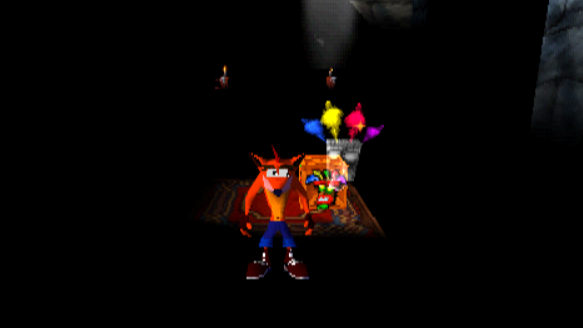Why I Love: Crash Bandicoot after 20 years

There’s a level in the first Crash Bandicoot called Lights Out. Twenty years before the short film and movie of the same name, before I’d watched The Blair Witch Project, before I filled my brain with the nightmares of modern horror that lurk in the dark, Lights Out terrified me.
If, after two decades, you don’t still have the worrying muscle memory to tap in the 24-symbol super password to unlock all levels and reach the Lights Out level immediately, let me explain its beautifully simple concept. Our favourite orange marsupial lands in a long castle corridor in almost darkness. An Aku Aku crate sits close by. Crash spins the crate and, as if by magic, the claustrophobic corridor ahead is flooded with light. Run though, it doesn’t stay that way for long. If you don’t manage to reach another crate in time, darkness falls once more, the light from Aku Aku shrinking to a mere spotlight.

It’s perfect. The gently menacing music is peppered with whispers and hisses, there are platforms that fall if you stay on them too long and rats with glowing red eyes that scuttle forwards and require a speedy leap to avoid. I would play, eyes glued to the TV, unblinking as I attempted to make it to the next checkpoint where I would bathe in the light before holding my breath and attempting the next section. Looking at it now, this was the beginning of the end for my career in anything other than finding new ways to scare myself silly. Sorry, mum.
I look at Lights Out now and I see an excellent concept and some good platforming, but back then I could feel the weight of the enormous silent castle around this one lone corridor. Hear the dragging feet in other perhaps identical floors above. I could feel watchful eyes on me in the dark. Nothing actually happened when the lights went off. Nothing grabbed you from the dark. You just had to attempt to fumble your way along to the next section without inevitably falling into a hole, but anything could have been out there. The potential for Crash meeting a previously unseen grisly end was apparently limitless.
Crash Bandicoot was my first time playing a game where it felt real. A technical marvel at the time because of the way it maximised the power of the original PlayStation, the ‘Sonic’s ass’ game (named because of the view of our hero) is full of fluttering butterflies and beautiful levels. I was enraptured by the idling animation where Crash would throw around Wumpa fruit. This was the first time I’d played as a character who got bored. The subtle difference between his celebratory happy face when he reached the end of a level and the exhausting wipe of the brow if he’d died was like a miracle. I’d gaze for hours at the view of the third island from the side scrolling Sunset Vista level. It didn’t matter that it was just a background to a side-scrolling section, you could see the future levels, just waiting there.
But this was meant to be about why I love it now and the reason is simple. It’s still all of these things. It’s impossible to disentangle my nostalgia for the franchise from my views of gaming now or at least remove the warm and fuzzies. The joy of riding a pig in Hog Wild two decades ago is still there when I play now. My muscles remember how to collect every box, avoid every hazard and spin every hard to reach box. I don’t even have to think about how to play. It’s still the same. I ploughed through dozens of levels last night and, almost hating myself for just how sucked in I was, I just had even more appreciation for the soundtrack. Not bad for a 20 year old game. Happy birthday, Crash. Lets drink to your remasters.
Why I Love encapsulates all the little details of gaming life that sometimes get ignored. It arrives every Friday at 0900 PST / 1700 GMT. Follow @gamesradar on Twitter for updates.
Weekly digests, tales from the communities you love, and more
Louise Blain is a journalist and broadcaster specialising in gaming, technology, and entertainment. She is the presenter of BBC Radio 3’s monthly Sound of Gaming show and has a weekly consumer tech slot on BBC Radio Scotland. She can also be found on BBC Radio 4, BBC Five Live, Netflix UK's YouTube Channel, and on The Evolution of Horror podcast. As well as her work on GamesRadar, Louise writes for NME, T3, and TechRadar. When she’s not working, you can probably find her watching horror movies or playing an Assassin’s Creed game and getting distracted by Photo Mode.



